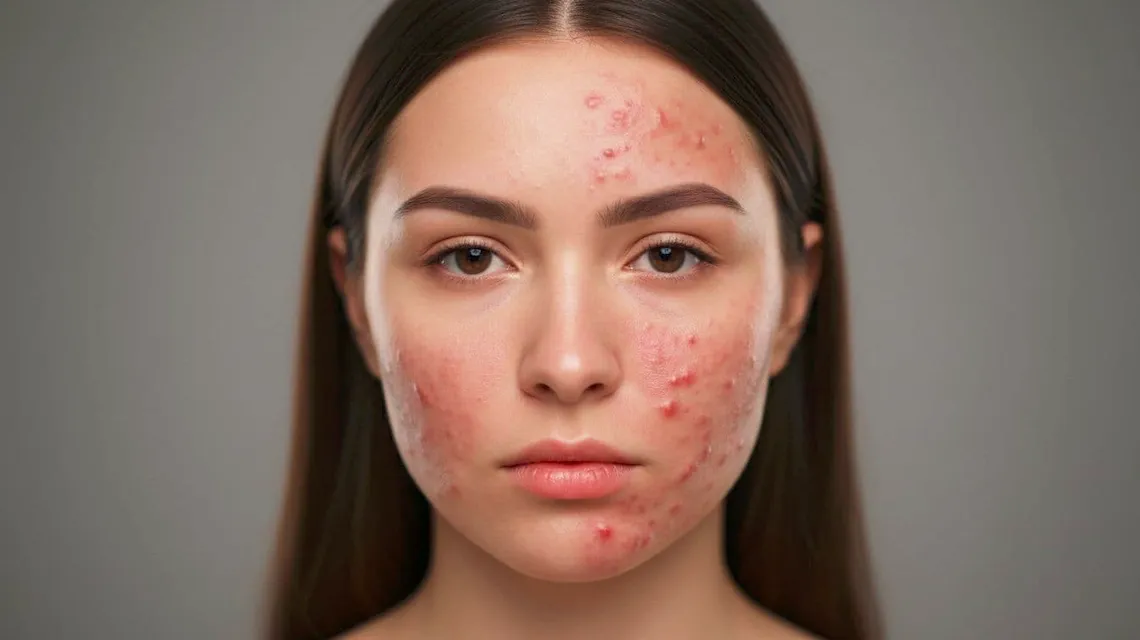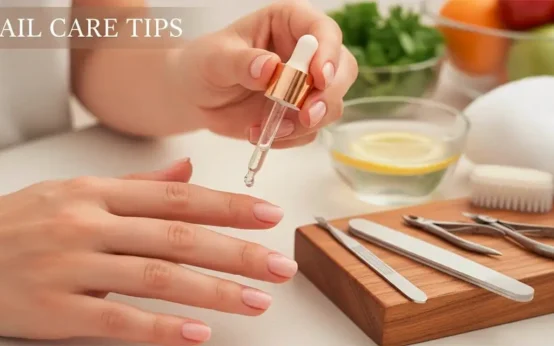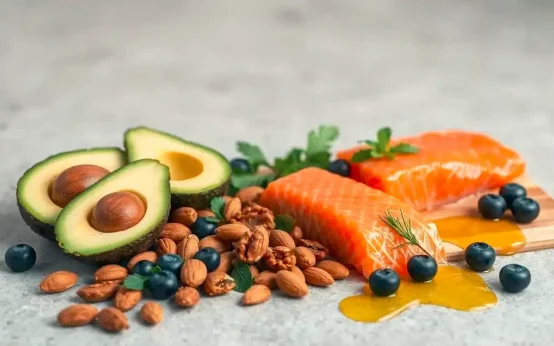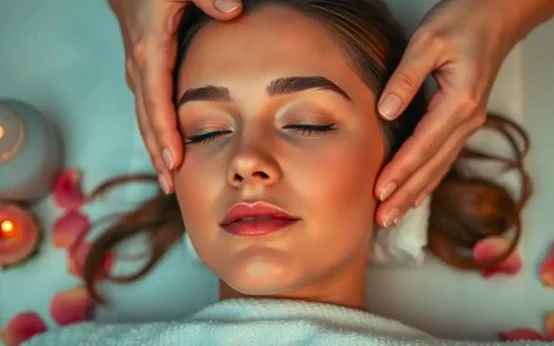Natural remedies for hormonal skin problems can feel like a lifeline when your face tells the story of your cycle or life stage. Chin acne before a period, oilier skin by day three, dry patches in winter, or dark spots after pregnancy, these are common. You are not alone.
This guide shows simple, safe steps that are gentle, budget friendly, and backed by common sense and basic science. Skin is personal, and it changes with hormones, stress, and seasons. Small changes add up over 4 to 8 weeks, not overnight. You will learn causes and signs, helpful natural ingredients, diet and lifestyle tips, and a smart plan for steady progress. You will also learn when to see a pro.
Keep it simple. Patch test new products. Build steady habits. Your skin can calm down.
Hormonal skin problems 101: causes, signs, and simple science
Hormones tell skin when to make oil, how fast to shed cells, and how to react to stress. When levels shift, skin often does too.
- Androgens, like testosterone, raise sebum. More oil can clog pores and feed acne bacteria.
- Estrogen helps keep skin plump, hydrated, and even. When it dips, skin can feel dry or sensitive.
- Progesterone may swell pores and trap oil in the late luteal week before a period.
- Cortisol, your stress hormone, raises inflammation and can spike oil.
- Insulin rises after high sugar meals. High insulin can drive androgens, which can worsen acne.
Timing matters. Puberty often brings more oil. The week before a period tends to trigger breakouts. Pregnancy can increase pigmentation, often called melasma. Menopause can thin the skin and reduce moisture.
Common signs include:
- Jawline or chin breakouts, often deeper cysts
- Oily T-zone with shine by noon
- Painful under-the-skin pimples
- Dark patches on cheeks or upper lip
- Dry or itchy skin in midlife
- Redness that lingers after a zit has healed
One clear takeaway, natural steps work best when you manage triggers at the same time.
Common triggers you can control today
Some habits push skin in the wrong direction. You can fix many of them fast.
- High sugar meals and energy drinks; switch to low glycemic meals.
- Skim milk for some people; test a short break if jawline acne is stubborn.
- Poor sleep and stress spikes; aim for 7 to 9 hours and try quick stress breaks.
- Over-washing and harsh scrubs; use a gentle cleanser twice a day.
- Heavy pore-clogging makeup; pick non-comedogenic options.
- Dirty pillowcases and sweaty hats; change pillowcases twice a week and wash after workouts.
When hormones swing most: puberty, period week, pregnancy, menopause
- Puberty: oil rises and pores clog. Tip, wash gently twice a day and avoid thick balms.
- Period week and late luteal: deeper chin cysts and more shine. Tip, start spot care 3 to 4 days before your usual flare.
- Pregnancy: melasma and sensitivity may show up. Tip, wear SPF 30+ daily and use azelaic acid if approved by your clinician.
- Menopause: dryness and redness increase. Tip, add ceramides and gentle oils, and avoid over-exfoliation.
How to spot hormonal acne vs other breakouts
Hormonal acne often lives along the jawline, chin, and neck. It flares before a period or with stress. Spots feel deeper and sore, with fewer blackheads.
Fungal acne shows tiny, uniform bumps on the forehead or hairline that itch. Contact acne from helmets or masks follows the edge of gear or straps.
Keep a simple diary for 6 weeks. Note dates, foods, stress, sleep, and breakouts. Patterns will stand out.
PCOS or thyroid clues to watch
Clues that point beyond simple acne include spaced or missing periods, chin or upper lip hair growth, deep cysts, weight gain or loss that is hard to explain, hair thinning, and cold or heat sensitivity. Mood shifts and low energy can also appear.
If you notice these, see a clinician for labs and a plan. You deserve supportive, non-judgmental care.
Natural remedies for hormonal skin problems that actually help
Natural does not mean risk free. These steps use gentle, studied ingredients and steady habits. Patch test first, go slow, and stop if irritation occurs. If you are pregnant, nursing, or on medication, talk with a clinician before starting supplements or new actives.
Topical basics:
- Gentle cleanser twice daily
- Non-comedogenic moisturizer to protect your barrier
- Mineral SPF 30+ every morning
Helpful actives, start low and slow:
- Willow bark for clogged pores
- Azelaic acid for dark spots and bumps
- Tea tree gel for spots
- Green tea serum for oil and redness
- Aloe vera for soothing
- Raw honey masks a few times a week
Internal support:
- Low glycemic meals to steady insulin
- Omega-3s to support a calm skin response
- Spearmint tea for androgen-linked chin acne
Stick with your routine for 8 weeks to judge changes. Natural remedies for hormonal skin problems work best with consistent use and smart lifestyle tweaks.
Topical heroes from nature and how to use them
- Tea tree oil 5% gel for spots, apply once daily on clean skin.
- Green tea extract 2 to 3% serum for oil and redness, use once or twice daily.
- Aloe vera gel 98 to 100% for soothing, apply daily as needed.
- Raw honey mask, smooth a thin layer for 10 to 15 minutes, rinse, 2 to 3 times a week.
- Willow bark, a natural source of salicylic acid, 0.5 to 2% for clogged pores. Start twice weekly.
- Azelaic acid 10% from grains for dark spots and bumps, once daily.
Patch test on the inner arm for 24 hours. Avoid using undiluted essential oils on your full face.
Teas and supplements that may support balance
- Spearmint tea: 2 cups daily may help people with chin acne tied to androgens.
- Omega-3s: 1 to 2 g EPA+DHA daily may reduce redness.
- Zinc: 15 to 30 mg daily if your diet is low; take with food.
- Magnesium glycinate: 200 to 400 mg at night for stress and sleep support.
- Myo-inositol: 2 to 4 g daily for people with PCOS, take as guided.
Cautions, talk to a clinician if you are pregnant, nursing, or on meds. Supplements can interact with drugs. Do not exceed label directions.
Anti-inflammatory eating for clearer skin
Use a simple plate method. Fill half your plate with veggies, a quarter with protein, and a quarter with high fiber carbs.
Swap to low glycemic carbs like oats, quinoa, berries, and beans. Favor olive oil, avocado, and nuts. Try yogurt or kefir if you tolerate dairy, or choose lactose free. Limit sugary drinks, energy drinks, and fast food.
If jawline acne will not budge, try a 2 to 4 week dairy break. Re-test slowly to see if it matters for you.
Quick routines, morning and night
Morning:
- Gentle cleanser
- Green tea or azelaic serum
- Light, non-comedogenic moisturizer
- Mineral SPF 30+
Night:
- Cleanse
- Aloe or a willow bark product if tolerated
- Simple moisturizer
Spots, tea tree gel on clean skin. Extras twice a week, a honey mask or a clay mask on oily areas only. Avoid over-scrubbing and mixing too many actives at once.
Lifestyle changes that calm hormones and skin, starting this week
Your daily habits shape oil, inflammation, and healing. You can start small and see results stack up.
- Eat low glycemic meals most days. Skin benefit, steadier insulin reduces oil surges and redness. Action, plan oatmeal with berries for breakfast and a grain bowl for lunch.
- Hydrate with water or herbal tea. Skin benefit, supports barrier and reduces dullness. Action, keep a bottle at your desk and sip 8 to 10 times by mid afternoon.
- Sleep on a schedule. Skin benefit, better repair lowers post-acne marks. Action, lights down at 10 pm, wake at 6 am.
- Manage stress in short bursts. Skin benefit, fewer cortisol spikes mean fewer flares. Action, try a 2 minute breathing break before meals.
- Move your body. Skin benefit, better insulin response and glow. Action, take a brisk 15 minute walk after dinner.
- Hygiene helps. Skin benefit, fewer clogged pores. Action, change pillowcases twice a week and cleanse after workouts.
- Sun smart habits. Skin benefit, prevents dark patches and post-blemish marks. Action, wear mineral SPF daily, reapply if outdoors.
Consistency beats intensity. Pick three habits you can keep this week.
Sleep habits that help skin heal
Aim for 7 to 9 hours. Keep a set sleep and wake time, even on weekends. Dim lights 1 hour before bed, and limit screens. Keep your room cool, dark, and quiet.
A simple routine helps, try magnesium glycinate or chamomile tea at night if they suit you. Better sleep lowers cortisol and oil spikes, which means fewer breakouts and calmer skin.
Stress relief you will actually do
You do not need an hour. Pick one quick tool:
- 4-7-8 breathing for 2 minutes
- A 10 minute walk outside
- A short yoga flow
Add one longer option per week, like a hobby, a call with a friend, or journaling. Steady stress care reduces flare ups and keeps hands off your face.
Exercise for insulin balance and glow
Aim for 150 minutes of brisk walking or cycling per week and 2 days of strength training. Movement improves insulin response and reduces inflammation. Your skin often looks brighter after a few weeks.
Cleanse skin after sweat. Keep hair products off the face and clean hat brims often.
Gut and skin connection made simple
Add one fermented food daily, like yogurt, kefir, kimchi, or sauerkraut if you tolerate them. Eat prebiotic fibers like oats, bananas, onions, and beans. Increase fiber slowly and drink water to avoid bloat.
Avoid unnecessary antibiotics. A calmer gut often means a calmer skin response.
Safe use, smart plans, and when to see a dermatologist
Safety keeps progress on track. Introduce one new product per week so you can spot what helps and what irritates. Keep a simple log and track for at least 8 weeks before judging results.
Create a weekly plan with a few key steps. Anchor them to times you already remember, like after brushing teeth or before breakfast. Keep backups for travel, like a mini cleanser and mineral SPF in your bag.
Know your red flags. If skin hurts, swells, or scars, get help. Dermatologists can combine gentle home care with medical tools when needed. If you have period changes or new hair growth on the face, ask your primary care clinician about labs. Hormones are health, not a moral scorecard.
Patch testing, dosing, and avoiding irritation
Patch test every new product on your inner arm or behind your ear for 24 hours. For oils, keep essential oils under 1 percent in a carrier, never straight on your full face.
Start actives twice weekly, then build to daily if skin stays calm. Add one new product per week at most. Stop and rest if you notice burning, swelling, or a rash.
A cycle-based routine you can follow
Days 1 to 7: focus on hydration. Soothe with aloe and do light exfoliation once.
Days 8 to 14: keep a steady routine, cleanse gently, and make SPF a priority.
Days 15 to 28: add one clay mask, start tea tree spot gel early, and focus on sleep and lower sugar.
If your cycle is irregular, pick two steady days each week for extras like masks or mild exfoliation.
Special cases: pregnancy, nursing, and teen skin
Pregnancy and nursing, skip retinoids. Keep salicylic acid low and on small areas only. Choose azelaic acid, aloe, honey, and mineral sunscreens. Ask your clinician before starting supplements.
Teens, keep it simple. Gentle cleanser, light moisturizer, a spot gel, and daily SPF. Avoid scrubs and thick oils. Consistency beats strong products.
If you are unsure, check with a clinician. Safety first.
Red flags that need medical care
See a dermatologist or primary care clinician if you have deep painful cysts that scar, sudden severe flares, signs of infection, dark patches that spread fast, or hair loss. Seek help for missed periods, new facial hair growth, or mood changes.
You may also need an endocrinologist if PCOS or thyroid problems are suspected. Early care can prevent scars and help your whole health.
Conclusion
Small, steady steps work. Natural remedies for hormonal skin problems help when you pair them with smart habits and patience. Know your triggers, pick a few safe topical and diet changes, build sleep and stress care, and track results for 8 weeks.
Be kind to your skin. Ask for help if red flags show up. Progress is not instant, but it is real. Patience plus consistency equals calmer, clearer skin.
Related post: Relieve Mild Sunburn Using Kitchen Ingredients for Skin
Natural Remedies for Hormonal Skin Problems: FAQ
What counts as a hormonal skin problem?
Breakouts that flare around your period, jawline acne, oiliness, and cysts point to hormone shifts. Melasma and postpartum changes also fit. PCOS can cause persistent acne and hair growth changes.
Can diet really affect hormonal acne?
Yes. Low glycemic meals can reduce insulin spikes, which may lower androgen activity. Many people see fewer breakouts when they cut sugary drinks, white bread, and candy.
Should I avoid dairy if I get hormonal breakouts?
Some do better with less skim milk and whey protein. Research links them to acne in some people. Try a 4 to 6 week dairy break, track your skin, then reintroduce to test your response.
Which supplements have decent evidence?
- Zinc, 15 to 30 mg per day, can reduce acne inflammation. Take with food. Long term use may need copper.
- Omega-3s, 1 to 2 g EPA plus DHA per day, support lower inflammation.
- Vitamin D helps if you are low. Check a blood test first.
- Inositol can help acne in PCOS by improving insulin sensitivity. Common dose is 2 to 4 g per day of myo-inositol.
Do herbal options help with androgen-driven acne?
Spearmint tea, 1 to 2 cups daily, showed small reductions in free testosterone in limited studies, mostly in PCOS. It is gentle and worth a 8 to 12 week trial. Chasteberry may help PMS symptoms, but it can affect hormones and medications. Avoid it if you are trying to get pregnant, pregnant, or on fertility treatment.
Are there safe topical botanicals for hormonal acne?
- Tea tree oil, diluted to 5 percent, can reduce mild acne. Patch test first, it can irritate.
- Green tea extract, topical or oral, may reduce oil and redness.
- Azelaic acid 10 to 15 percent helps clogged pores, redness, and melasma. It is pregnancy friendly.
- Sulfur masks help oil and clogged pores without bleaching fabric.
How do I apply tea tree oil safely?
Never use it neat. Mix a few drops in a carrier oil you tolerate, like squalane, or buy a 5 percent gel. Start every other night, spot treat only, and patch test on the jawline first.
Can probiotics help hormonal acne?
They may help the gut-skin axis. Lactobacillus and Bifidobacterium strains can reduce inflammation and support the skin barrier. Benefits are modest. Choose a product with listed strains, take daily for 8 to 12 weeks, and pair with fiber.
What about turmeric or curcumin?
Curcumin has anti-inflammatory effects. Some see calmer skin with 500 to 1000 mg per day of a bioavailable form, taken with food. It can interact with blood thinners. Topical turmeric pastes stain and can irritate, so use caution.
Which lifestyle habits matter most?
- Sleep 7 to 9 hours, poor sleep raises cortisol and oil.
- Train regularly, even brisk walks can help insulin control.
- Manage stress with breath work, yoga, or short breaks.
- Do not smoke or vape, they slow healing and trigger inflammation.
- Keep hands off your face, and change pillowcases twice a week.
How should I sync skincare with my cycle?
- Follicular phase, days after your period, add gentle exfoliation 1 to 2 times per week.
- Ovulation, oil can rise, use clay masks and non-comedogenic moisturizer.
- Luteal phase, week before period, focus on calming care, azelaic acid at night, avoid harsh scrubs.
- During your period, keep it simple, hydrate and spot treat only.
Do natural oils clog pores?
Some do. Coconut oil often clogs acne-prone skin. Better picks are squalane, hemp seed oil, or jojoba. Always patch test.
Can I fade hormonal melasma with natural options?
Azelaic acid, vitamin C, niacinamide, and daily sunscreen help most. Licorice extract and green tea can support brightening. Sun protection is crucial, use SPF 30 or higher every day, reapply every 2 hours outdoors.
How long till I see results from natural remedies?
Give it 8 to 12 weeks. Hormonal cycles take time to shift. Track with photos and a simple skin diary so you can spot patterns.
What should I do if I have PCOS and acne?
Focus on steady blood sugar, whole foods, fiber, protein at each meal, and regular movement. Consider inositol and omega-3s. Work with a clinician on labs and treatment. Spironolactone or combined methods with topicals often help if needed.
Are natural remedies safe during pregnancy or breastfeeding?
Skip high dose herbal hormones like chasteberry and high dose salicylic acid. Azelaic acid, sulfur, and niacinamide are considered safe. Always confirm with your clinician.
How do I build a simple, skin-friendly routine?
- Cleanser, gentle, twice daily.
- Treatment, azelaic acid or a targeted serum at night.
- Moisturizer, light and non-comedogenic.
- Sunscreen, SPF 30 or higher, every morning. Keep it steady for at least 8 weeks before judging.
When should I see a dermatologist?
- Cysts that hurt or scar.
- Breakouts that do not improve after 3 months of care.
- Sudden facial hair growth, hair loss, or irregular periods.
- Signs of infection or severe redness. You can combine natural methods with prescription care for faster, safer results.




 How To Remove Sun Tan From Hands
How To Remove Sun Tan From Hands  How to Take Care Your Nails
How to Take Care Your Nails  How to Improve Good Cholesterol (HDL)
How to Improve Good Cholesterol (HDL)  Hormone Health Tips for Women
Hormone Health Tips for Women  Heal Dry Damaged Hair: A Simple Plan That Works
Heal Dry Damaged Hair: A Simple Plan That Works  How to Look Much Younger Without Drastic Changes
How to Look Much Younger Without Drastic Changes